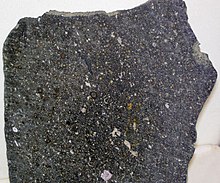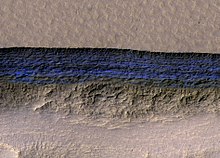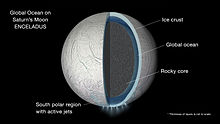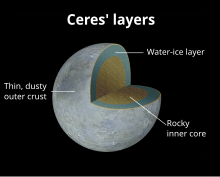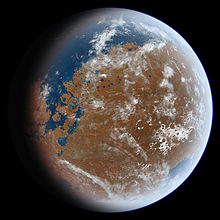Annotated color version of the original 1824 Carnot heat engine
showing the hot body (boiler), working body (system, steam), and cold
body (water), the letters labeled according to the stopping points in Carnot cycle.
Thermodynamics is a branch of physics that deals with heat and temperature, and their relation to energy, work, radiation, and properties of matter. The behavior of these quantities is governed by the four laws of thermodynamics which convey a quantitative description using measurable macroscopic physical quantities, but may be explained in terms of microscopic constituents by statistical mechanics. Thermodynamics applies to a wide variety of topics in science and engineering, especially physical chemistry, chemical engineering and mechanical engineering, but also in fields as complex as meteorology.
Historically, thermodynamics developed out of a desire to increase the efficiency of early steam engines, particularly through the work of French physicist Nicolas Léonard Sadi Carnot (1824) who believed that engine efficiency was the key that could help France win the Napoleonic Wars. Scots-Irish physicist Lord Kelvin was the first to formulate a concise definition of thermodynamics in 1854
which stated, "Thermo-dynamics is the subject of the relation of heat
to forces acting between contiguous parts of bodies, and the relation of
heat to electrical agency."
The initial application of thermodynamics to mechanical heat engines was quickly extended to the study of chemical compounds and chemical reactions. Chemical thermodynamics studies the nature of the role of entropy in the process of chemical reactions and has provided the bulk of expansion and knowledge of the field. Other formulations of thermodynamics emerged. Statistical thermodynamics, or statistical mechanics, concerns itself with statistical predictions of the collective motion of particles from their microscopic behavior. In 1909, Constantin Carathéodory presented a purely mathematical approach in an axiomatic formulation, a description often referred to as geometrical thermodynamics.
Introduction
A description of any thermodynamic system employs the four laws of thermodynamics that form an axiomatic basis. The first law specifies that energy can be exchanged between physical systems as heat and work. The second law defines the existence of a quantity called entropy,
that describes the direction, thermodynamically, that a system can
evolve and quantifies the state of order of a system and that can be
used to quantify the useful work that can be extracted from the system.
In thermodynamics, interactions between large ensembles of
objects are studied and categorized. Central to this are the concepts of
the thermodynamic system and its surroundings.
A system is composed of particles, whose average motions define its
properties, and those properties are in turn related to one another
through equations of state. Properties can be combined to express internal energy and thermodynamic potentials, which are useful for determining conditions for equilibrium and spontaneous processes.
With these tools, thermodynamics can be used to describe how
systems respond to changes in their environment. This can be applied to a
wide variety of topics in science and engineering, such as engines, phase transitions, chemical reactions, transport phenomena, and even black holes. The results of thermodynamics are essential for other fields of physics and for chemistry, chemical engineering, corrosion engineering, aerospace engineering, mechanical engineering, cell biology, biomedical engineering, materials science, and economics, to name a few.
This article is focused mainly on classical thermodynamics which primarily studies systems in thermodynamic equilibrium. Non-equilibrium thermodynamics is often treated as an extension of the classical treatment, but statistical mechanics has brought many advances to that field.
The thermodynamicists
representative of the original eight founding schools of
thermodynamics. The schools with the most-lasting effect in founding the
modern versions of thermodynamics are the Berlin school, particularly
as established in Rudolf Clausius’s 1865 textbook The Mechanical Theory of Heat, the Vienna school, with the statistical mechanics of Ludwig Boltzmann, and the Gibbsian school at Yale University, American engineer Willard Gibbs' 1876 On the Equilibrium of Heterogeneous Substances launching chemical thermodynamics.
History
The history of thermodynamics as a scientific discipline generally begins with Otto von Guericke who, in 1650, built and designed the world's first vacuum pump and demonstrated a vacuum using his Magdeburg hemispheres. Guericke was driven to make a vacuum in order to disprove Aristotle's long-held supposition that 'nature abhors a vacuum'. Shortly after Guericke, the English physicist and chemist Robert Boyle had learned of Guericke's designs and, in 1656, in coordination with English scientist Robert Hooke, built an air pump. Using this pump, Boyle and Hooke noticed a correlation between pressure, temperature, and volume. In time, Boyle's Law was formulated, which states that pressure and volume are inversely proportional. Then, in 1679, based on these concepts, an associate of Boyle's named Denis Papin built a steam digester, which was a closed vessel with a tightly fitting lid that confined steam until a high pressure was generated.
Later designs implemented a steam release valve that kept the
machine from exploding. By watching the valve rhythmically move up and
down, Papin conceived of the idea of a piston
and a cylinder engine. He did not, however, follow through with his
design. Nevertheless, in 1697, based on Papin's designs, engineer Thomas Savery built the first engine, followed by Thomas Newcomen
in 1712. Although these early engines were crude and inefficient, they
attracted the attention of the leading scientists of the time.
The fundamental concepts of heat capacity and latent heat, which were necessary for the development of thermodynamics, were developed by Professor Joseph Black at the University of Glasgow, where James Watt
was employed as an instrument maker. Black and Watt performed
experiments together, but it was Watt who conceived the idea of the external condenser which resulted in a large increase in steam engine efficiency. Drawing on all the previous work led Sadi Carnot, the "father of thermodynamics", to publish Reflections on the Motive Power of Fire (1824), a discourse on heat, power, energy and engine efficiency. The book outlined the basic energetic relations between the Carnot engine, the Carnot cycle, and motive power. It marked the start of thermodynamics as a modern science.
The first thermodynamic textbook was written in 1859 by William Rankine, originally trained as a physicist and a civil and mechanical engineering professor at the University of Glasgow. The first and second laws of thermodynamics emerged simultaneously in the 1850s, primarily out of the works of William Rankine, Rudolf Clausius, and William Thomson (Lord Kelvin).
The foundations of statistical thermodynamics were set out by physicists such as James Clerk Maxwell, Ludwig Boltzmann, Max Planck, Rudolf Clausius and J. Willard Gibbs.
During the years 1873–76 the American mathematical physicist Josiah Willard Gibbs published a series of three papers, the most famous being On the Equilibrium of Heterogeneous Substances, in which he showed how thermodynamic processes, including chemical reactions, could be graphically analyzed, by studying the energy, entropy, volume, temperature and pressure of the thermodynamic system in such a manner, one can determine if a process would occur spontaneously. Also Pierre Duhem in the 19th century wrote about chemical thermodynamics. During the early 20th century, chemists such as Gilbert N. Lewis, Merle Randall, and E. A. Guggenheim applied the mathematical methods of Gibbs to the analysis of chemical processes.
Etymology
The etymology of thermodynamics has an intricate history. It was first spelled in a hyphenated form as an adjective (thermo-dynamic) and from 1854 to 1868 as the noun thermo-dynamics to represent the science of generalized heat engines.
American biophysicist Donald Haynie claims that thermodynamics was coined in 1840 from the Greek root θέρμη therme, meaning “heat”, and δύναμις dynamis, meaning “power”.
Pierre Perrot claims that the term thermodynamics was coined by James Joule in 1858 to designate the science of relations between heat and power, however, Joule never used that term, but used instead the term perfect thermo-dynamic engine in reference to Thomson's 1849 phraseology.
By 1858, thermo-dynamics, as a functional term, was used in William Thomson's paper "An Account of Carnot's Theory of the Motive Power of Heat."
Branches of thermodynamics
The
study of thermodynamical systems has developed into several related
branches, each using a different fundamental model as a theoretical or
experimental basis, or applying the principles to varying types of
systems.
Classical thermodynamics
Classical
thermodynamics is the description of the states of thermodynamic
systems at near-equilibrium, that uses macroscopic, measurable
properties. It is used to model exchanges of energy, work and heat based
on the laws of thermodynamics. The qualifier classical
reflects the fact that it represents the first level of understanding
of the subject as it developed in the 19th century and describes the
changes of a system in terms of macroscopic empirical (large scale, and
measurable) parameters. A microscopic interpretation of these concepts
was later provided by the development of statistical mechanics.
Statistical mechanics
Statistical mechanics,
also called statistical thermodynamics, emerged with the development of
atomic and molecular theories in the late 19th century and early 20th
century, and supplemented classical thermodynamics with an
interpretation of the microscopic interactions between individual
particles or quantum-mechanical states. This field relates the
microscopic properties of individual atoms and molecules to the
macroscopic, bulk properties of materials that can be observed on the
human scale, thereby explaining classical thermodynamics as a natural
result of statistics, classical mechanics, and quantum theory at the microscopic level.
Chemical thermodynamics
Chemical thermodynamics is the study of the interrelation of energy with chemical reactions or with a physical change of state within the confines of the laws of thermodynamics.
Equilibrium thermodynamics
Equilibrium thermodynamics
is the study of transfers of matter and energy in systems or bodies
that, by agencies in their surroundings, can be driven from one state of
thermodynamic equilibrium to another. The term 'thermodynamic
equilibrium' indicates a state of balance, in which all macroscopic
flows are zero; in the case of the simplest systems or bodies, their
intensive properties are homogeneous, and their pressures are
perpendicular to their boundaries. In an equilibrium state there are no
unbalanced potentials, or driving forces, between macroscopically
distinct parts of the system. A central aim in equilibrium
thermodynamics is: given a system in a well-defined initial equilibrium
state, and given its surroundings, and given its constitutive walls, to
calculate what will be the final equilibrium state of the system after a
specified thermodynamic operation has changed its walls or
surroundings.
Non-equilibrium thermodynamics is a branch of thermodynamics that deals with systems that are not in thermodynamic equilibrium.
Most systems found in nature are not in thermodynamic equilibrium
because they are not in stationary states, and are continuously and
discontinuously subject to flux of matter and energy to and from other
systems. The thermodynamic study of non-equilibrium systems requires
more general concepts than are dealt with by equilibrium thermodynamics.
Many natural systems still today remain beyond the scope of currently
known macroscopic thermodynamic methods.
Laws of thermodynamics
Thermodynamics is principally based on a set of four laws which are
universally valid when applied to systems that fall within the
constraints implied by each. In the various theoretical descriptions of
thermodynamics these laws may be expressed in seemingly differing forms,
but the most prominent formulations are the following.
Zeroth Law
The zeroth law of thermodynamics states: If two systems are each in thermal equilibrium with a third, they are also in thermal equilibrium with each other.
This statement implies that thermal equilibrium is an equivalence relation on the set of thermodynamic systems under consideration. Systems are said to be in equilibrium if the small, random exchanges between them (e.g. Brownian motion)
do not lead to a net change in energy. This law is tacitly assumed in
every measurement of temperature. Thus, if one seeks to decide whether
two bodies are at the same temperature, it is not necessary to bring them into contact and measure any changes of their observable properties in time. The law provides an empirical definition of temperature, and justification for the construction of practical thermometers.
The zeroth law was not initially recognized as a separate law of
thermodynamics, as its basis in thermodynamical equilibrium was implied
in the other laws. The first, second, and third laws had been
explicitly stated already, and found common acceptance in the physics
community before the importance of the zeroth law for the definition of
temperature was realized. As it was impractical to renumber the other
laws, it was named the zeroth law.
First Law
The first law of thermodynamics states: In a process without transfer of matter, the change in internal energy, ΔU, of a thermodynamic system is equal to the energy gained as heat, Q, less the thermodynamic work, W, done by the system on its surroundings.
- .
For processes that include transfer of matter, a further statement is needed: With
due account of the respective fiducial reference states of the systems,
when two systems, which may be of different chemical compositions,
initially separated only by an impermeable wall, and otherwise isolated,
are combined into a new system by the thermodynamic operation of
removal of the wall, then
- ,
where U0 denotes the internal energy of the combined system, and U1 and U2 denote the internal energies of the respective separated systems.
Adapted for thermodynamics, this law is an expression of the principle of conservation of energy, which states that energy can be transformed (changed from one form to another), but cannot be created or destroyed.
Internal energy is a principal property of the thermodynamic state,
while heat and work are modes of energy transfer by which a process may
change this state. A change of internal energy of a system may be
achieved by any combination of heat added or removed and work performed
on or by the system. As a function of state,
the internal energy does not depend on the manner, or on the path
through intermediate steps, by which the system arrived at its state.
Second Law
The second law of thermodynamics states: Heat cannot spontaneously flow from a colder location to a hotter location.
This law is an expression of the universal principle of decay
observable in nature. The second law is an observation of the fact that
over time, differences in temperature, pressure, and chemical potential
tend to even out in a physical system that is isolated from the outside
world. Entropy
is a measure of how much this process has progressed. The entropy of an
isolated system which is not in equilibrium will tend to increase over
time, approaching a maximum value at equilibrium. However, principles
guiding systems that are far from equilibrium are still debatable. One
of such principles is the maximum entropy production principle. It states that non-equilibrium systems behave such a way as to maximize its entropy production.
In classical thermodynamics, the second law is a basic postulate
applicable to any system involving heat energy transfer; in statistical
thermodynamics, the second law is a consequence of the assumed
randomness of molecular chaos. There are many versions of the second
law, but they all have the same effect, which is to explain the
phenomenon of irreversibility in nature.
Third Law
The third law of thermodynamics states: As
the temperature of a system approaches absolute zero, all processes
cease and the entropy of the system approaches a minimum value.
This law of thermodynamics is a statistical law of nature regarding entropy and the impossibility of reaching absolute zero
of temperature. This law provides an absolute reference point for the
determination of entropy. The entropy determined relative to this point
is the absolute entropy. Alternate definitions include "the entropy of
all systems and of all states of a system is smallest at absolute zero,"
or equivalently "it is impossible to reach the absolute zero of
temperature by any finite number of processes".
Absolute zero, at which all activity would stop if it were
possible to achieve, is −273.15 °C (degrees Celsius), or −459.67 °F
(degrees Fahrenheit), or 0 K (kelvin), or 0° R (degrees Rankine).
System models
A diagram of a generic thermodynamic system
An important concept in thermodynamics is the thermodynamic system, which is a precisely defined region of the universe under study. Everything in the universe except the system is called the surroundings. A system is separated from the remainder of the universe by a boundary which may be a physical boundary or notional, but which by convention defines a finite volume. Exchanges of work, heat, or matter between the system and the surroundings take place across this boundary.
In practice, the boundary of a system is simply an imaginary
dotted line drawn around a volume within which is going to be a change
in the internal energy
of that volume. Anything that passes across the boundary that effects a
change in the internal energy of the system needs to be accounted for
in the energy balance equation. The volume can be the region
surrounding a single atom resonating energy, such as Max Planck defined in 1900; it can be a body of steam or air in a steam engine, such as Sadi Carnot defined in 1824; it can be the body of a tropical cyclone, such as Kerry Emanuel theorized in 1986 in the field of atmospheric thermodynamics; it could also be just one nuclide (i.e. a system of quarks) as hypothesized in quantum thermodynamics, or the event horizon of a black hole.
Boundaries are of four types: fixed, movable, real, and
imaginary. For example, in an engine, a fixed boundary means the piston
is locked at its position, within which a constant volume process might
occur. If the piston is allowed to move that boundary is movable while
the cylinder and cylinder head boundaries are fixed. For closed
systems, boundaries are real while for open systems boundaries are often
imaginary. In the case of a jet engine, a fixed imaginary boundary
might be assumed at the intake of the engine, fixed boundaries along the
surface of the case and a second fixed imaginary boundary across the
exhaust nozzle.
Generally, thermodynamics distinguishes three classes of systems, defined in terms of what is allowed to cross their boundaries:
| Type of system | Mass flow | Work | Heat |
|---|---|---|---|
| Open | |||
| Closed | |||
| Thermally isolated | |||
| Mechanically isolated | |||
| Isolated |
As time passes in an isolated system, internal differences of
pressures, densities, and temperatures tend to even out. A system in
which all equalizing processes have gone to completion is said to be in a
state of thermodynamic equilibrium.
Once in thermodynamic equilibrium, a system's properties are, by
definition, unchanging in time. Systems in equilibrium are much simpler
and easier to understand than are systems which are not in equilibrium.
Often, when analysing a dynamic thermodynamic process, the simplifying
assumption is made that each intermediate state in the process is at
equilibrium, producing thermodynamic processes which develop so slowly
as to allow each intermediate step to be an equilibrium state and are
said to be reversible processes.
States and processes
When a system is at equilibrium under a given set of conditions, it is said to be in a definite thermodynamic state. The state of the system can be described by a number of state quantities that do not depend on the process by which the system arrived at its state. They are called intensive variables or extensive variables according to how they change when the size of the system changes. The properties of the system can be described by an equation of state
which specifies the relationship between these variables. State may be
thought of as the instantaneous quantitative description of a system
with a set number of variables held constant.
A thermodynamic process
may be defined as the energetic evolution of a thermodynamic system
proceeding from an initial state to a final state. It can be described
by process quantities.
Typically, each thermodynamic process is distinguished from other
processes in energetic character according to what parameters, such as
temperature, pressure, or volume, etc., are held fixed; Furthermore, it
is useful to group these processes into pairs, in which each variable
held constant is one member of a conjugate pair.
Several commonly studied thermodynamic processes are:
- Adiabatic process: occurs without loss or gain of energy by heat
- Isenthalpic process: occurs at a constant enthalpy
- Isentropic process: a reversible adiabatic process, occurs at a constant entropy
- Isobaric process: occurs at constant pressure
- Isochoric process: occurs at constant volume (also called isometric/isovolumetric)
- Isothermal process: occurs at a constant temperature
- Steady state process: occurs without a change in the internal energy
Instrumentation
There are two types of thermodynamic instruments, the meter and the reservoir. A thermodynamic meter is any device which measures any parameter of a thermodynamic system.
In some cases, the thermodynamic parameter is actually defined in terms
of an idealized measuring instrument. For example, the zeroth law
states that if two bodies are in thermal equilibrium with a third body,
they are also in thermal equilibrium with each other. This principle,
as noted by James Maxwell in 1872, asserts that it is possible to measure temperature. An idealized thermometer is a sample of an ideal gas at constant pressure. From the ideal gas law pV=nRT,
the volume of such a sample can be used as an indicator of temperature;
in this manner it defines temperature. Although pressure is defined
mechanically, a pressure-measuring device, called a barometer may also be constructed from a sample of an ideal gas held at a constant temperature. A calorimeter is a device which is used to measure and define the internal energy of a system.
A thermodynamic reservoir is a system which is so large that its
state parameters are not appreciably altered when it is brought into
contact with the system of interest. When the reservoir is brought into
contact with the system, the system is brought into equilibrium with the
reservoir. For example, a pressure reservoir is a system at a
particular pressure, which imposes that pressure upon the system to
which it is mechanically connected. The Earth's atmosphere is often used
as a pressure reservoir. If ocean water is used to cool a power plant,
the ocean is often a temperature reservoir in the analysis of the power
plant cycle.
Conjugate variables
The central concept of thermodynamics is that of energy, the ability to do work. By the First Law,
the total energy of a system and its surroundings is conserved. Energy
may be transferred into a system by heating, compression, or addition of
matter, and extracted from a system by cooling, expansion, or
extraction of matter. In mechanics, for example, energy transfer equals the product of the force applied to a body and the resulting displacement.
Conjugate variables are pairs of thermodynamic concepts, with the first being akin to a "force" applied to some thermodynamic system,
the second being akin to the resulting "displacement," and the product
of the two equalling the amount of energy transferred. The common
conjugate variables are:
- Pressure-volume (the mechanical parameters);
- Temperature-entropy (thermal parameters);
- Chemical potential-particle number (material parameters).
Potentials
Thermodynamic potentials
are different quantitative measures of the stored energy in a system.
Potentials are used to measure the energy changes in systems as they
evolve from an initial state to a final state. The potential used
depends on the constraints of the system, such as constant temperature
or pressure. For example, the Helmholtz and Gibbs energies are the
energies available in a system to do useful work when the temperature
and volume or the pressure and temperature are fixed, respectively.
The five most well known potentials are:
| Name | Symbol | Formula | Natural variables |
|---|---|---|---|
| Internal energy | |||
| Helmholtz free energy | |||
| Enthalpy | |||
| Gibbs free energy | |||
| Landau Potential | , |
where is the temperature, the entropy, the pressure, the volume, the chemical potential, the number of particles in the system, and is the count of particles types in the system.
Thermodynamic potentials can be derived from the energy balance
equation applied to a thermodynamic system. Other thermodynamic
potentials can also be obtained through Legendre transformation.
































